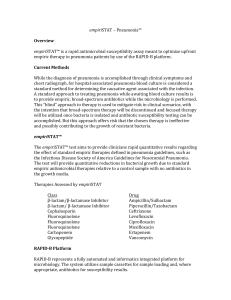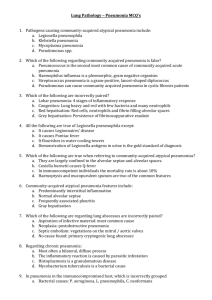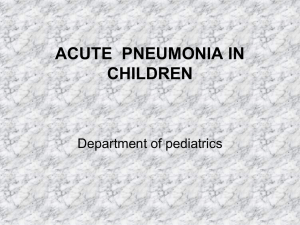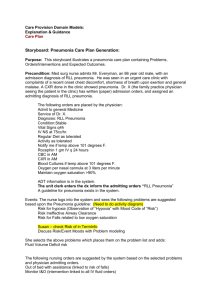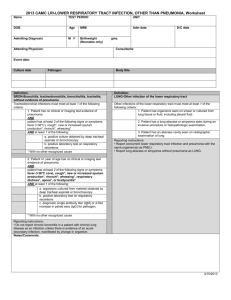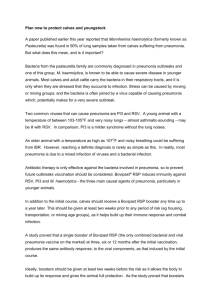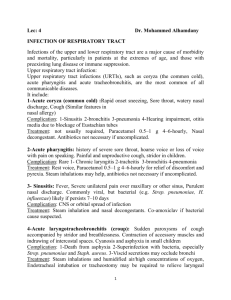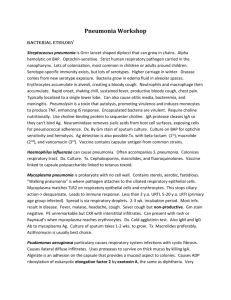File
advertisement
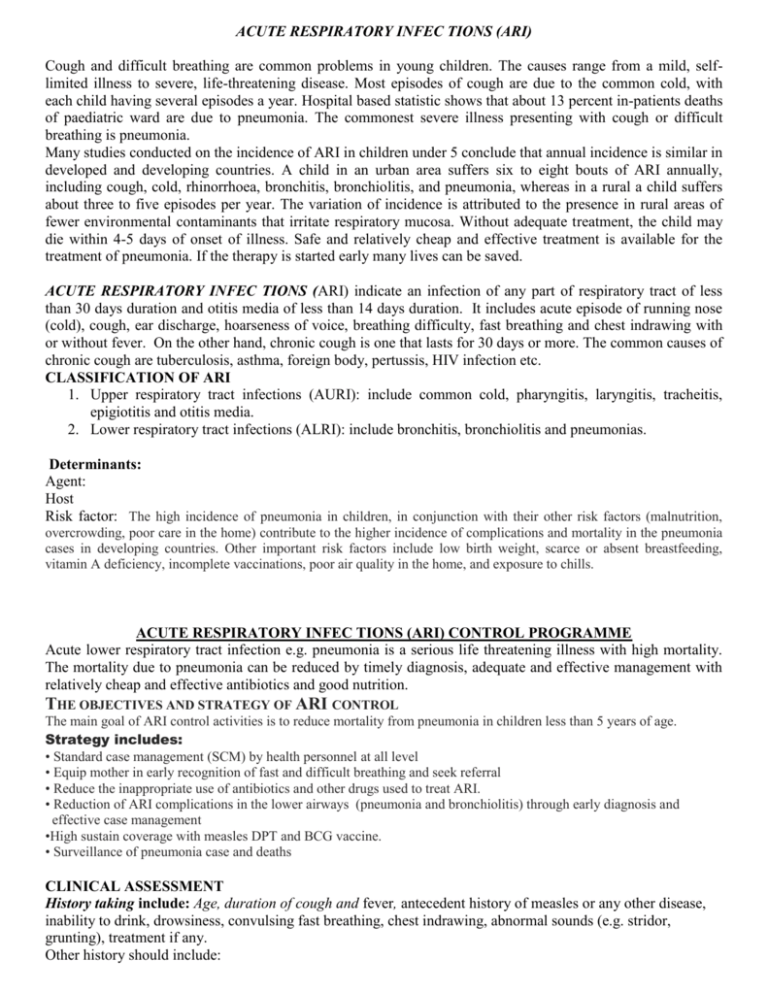
ACUTE RESPIRATORY INFEC TIONS (ARI) Cough and difficult breathing are common problems in young children. The causes range from a mild, selflimited illness to severe, life-threatening disease. Most episodes of cough are due to the common cold, with each child having several episodes a year. Hospital based statistic shows that about 13 percent in-patients deaths of paediatric ward are due to pneumonia. The commonest severe illness presenting with cough or difficult breathing is pneumonia. Many studies conducted on the incidence of ARI in children under 5 conclude that annual incidence is similar in developed and developing countries. A child in an urban area suffers six to eight bouts of ARI annually, including cough, cold, rhinorrhoea, bronchitis, bronchiolitis, and pneumonia, whereas in a rural a child suffers about three to five episodes per year. The variation of incidence is attributed to the presence in rural areas of fewer environmental contaminants that irritate respiratory mucosa. Without adequate treatment, the child may die within 4-5 days of onset of illness. Safe and relatively cheap and effective treatment is available for the treatment of pneumonia. If the therapy is started early many lives can be saved. ACUTE RESPIRATORY INFEC TIONS (ARI) indicate an infection of any part of respiratory tract of less than 30 days duration and otitis media of less than 14 days duration. It includes acute episode of running nose (cold), cough, ear discharge, hoarseness of voice, breathing difficulty, fast breathing and chest indrawing with or without fever. On the other hand, chronic cough is one that lasts for 30 days or more. The common causes of chronic cough are tuberculosis, asthma, foreign body, pertussis, HIV infection etc. CLASSIFICATION OF ARI 1. Upper respiratory tract infections (AURI): include common cold, pharyngitis, laryngitis, tracheitis, epigiotitis and otitis media. 2. Lower respiratory tract infections (ALRI): include bronchitis, bronchiolitis and pneumonias. Determinants: Agent: Host Risk factor: The high incidence of pneumonia in children, in conjunction with their other risk factors (malnutrition, overcrowding, poor care in the home) contribute to the higher incidence of complications and mortality in the pneumonia cases in developing countries. Other important risk factors include low birth weight, scarce or absent breastfeeding, vitamin A deficiency, incomplete vaccinations, poor air quality in the home, and exposure to chills. ACUTE RESPIRATORY INFEC TIONS (ARI) CONTROL PROGRAMME Acute lower respiratory tract infection e.g. pneumonia is a serious life threatening illness with high mortality. The mortality due to pneumonia can be reduced by timely diagnosis, adequate and effective management with relatively cheap and effective antibiotics and good nutrition. THE OBJECTIVES AND STRATEGY OF ARI CONTROL The main goal of ARI control activities is to reduce mortality from pneumonia in children less than 5 years of age. Strategy includes: • Standard case management (SCM) by health personnel at all level • Equip mother in early recognition of fast and difficult breathing and seek referral • Reduce the inappropriate use of antibiotics and other drugs used to treat ARI. • Reduction of ARI complications in the lower airways (pneumonia and bronchiolitis) through early diagnosis and effective case management •High sustain coverage with measles DPT and BCG vaccine. • Surveillance of pneumonia case and deaths CLINICAL ASSESSMENT History taking include: Age, duration of cough and fever, antecedent history of measles or any other disease, inability to drink, drowsiness, convulsing fast breathing, chest indrawing, abnormal sounds (e.g. stridor, grunting), treatment if any. Other history should include: Exposure to someone with tuberculosis (or chronic cough) in the family History of choking or sudden onset of symptoms Known HIV infection Immunization history: BCG, DPT, measles, Hib Personal or family history of asthma. Criteria for diagnosis: 1. Respiratory rate: The respiration rate may be counted by looking to exposed abdominal/lower chest wall movement. Counting should be made for 1 minute when the child is calm. However, if the rate is more than 60/ minute in a young infant (>2 months age), a repeat count should be made. Fast breathing is a sign of pneumonia. Some time fast breathing may be absent in severe pneumonia if the child become exhausted and effort need to expand the lung is too great Fast breathing is present when the respiratory rate is: 60 or more in a child less than 2 months of age. 50 or more in a child 2 to 12 months of age. 40 or more in a child 1 to 5 years of age 2. Lower chest wall indrawing: In normal breathing, the whole chest wall including the abdomen move OUT when the young infant breathes IN. When chest indrawing is present, the lower chest wall goes IN during inspiration. Only the soft tissue movement between the ribs or above the clavicle during inspiration is not chest wall indrawing. Chest indrawing should be examined in a quite/clam baby or while sleeping. Mild chest indrawing is normal in a young infant because the chest wall is soft. Severe chest indrawing is very deep and easily detected. Severe chest indrawing is a sign of pneumonia and is serious in a young infant. 3. Stridor is a harsh noise during inspiration, which is due to narrowing of upper respiratory passage (oropharynx, subglottis or trachea) .The conditions are termed as croup commonly. If the obstruction is severe, stridor may also occur during expiration. 4. Wheeze is a high-pitched whistling sound near the end of expiration. It is caused by spasmodic narrowing of the distal airways. During the first 2 years of life, wheezing is mostly caused by acute viral respiratory infections such as bronchiolitis or coughs and colds. After 2 years of age, usually it is due to asthma. Sometimes children with pneumonia may present with wheeze. It is important always to consider pneumonia as a diagnosis, particularly in the first 2 years of life. 5. LOOK for nasal flaring: Nasal flaring is widening of the nostrils when the young infant breathes in. 6. LOOK and LISTEN for grunting: Grunting is the soft, short sound a young infant makes when breathing out. Grunting occurs when an infant is having trouble breathing. 7. Body temperature: Fever & Hypothermia 8. Nutritional status 9. Cyanosis CLASSIFICATION OF ARI: For the practical purposes the cases are classified as followed, which vary in different age group. Child of aged 2 months to 5 years 1. No pneumonia, cough or cold 2. Pneumonia 3. Severe pneumonia 4. Very severe illness Young infant (<2 month of age): 1. No pneumonia, cough or cold 2. Severe pneumonia- any pneumonia in young infant is considered as severe. 3. Very severe illness Classification of the severity of pneumonia (2 month to 5 years) Sign or symptom Classification Place of treatment and action and No pneumonia, Home care Cough cough or cold No fast breathing No antibiotics is required No chest indrawing Home care / Care at health center Pneumonia Fast breathing Give appropriate antibiotic for 5 days Follow up in 2 days Advise the mother when to return Lower chest wall indrawing Severe Refer urgently to hospital with first dose pneumonia of antibiotic Give recommended antibiotic Pneumonia along with danger sign: Very severe Admit to hospital pneumonia Not able to drink, Convulsion, Give recommended antibiotic Abnormally sleepy, Stridor or wheeze in a calm child, Central cyanosis, Severe under nutrition. No pneumonia, cough or cold These are common, self-limited viral infections that require only supportive care. Antibiotics should not be given. Wheeze or stridor may occur in some children, especially infants. Most episodes end within 14 days. Cough lasting 30 days or more may be caused by tuberculosis, asthma, pertussis or symptomatic HIV infection. Diagnosis: Common features: Cough, nasal discharge, mouth breathing, and fever. The following are absent: Fast breathing Lower chest wall indrawing Stridor when the child is calm General danger signs Treatment Home remedy Soothe the throat and relieve the cough with a safe remedy, such as a warm, sweet drink. Clear secretions from the child’s nose before feeds using a cloth soaked in water Relieve high fever with paracetamol Following medication are not indicated o Antibiotic is (they are not effective and do not prevent pneumonia) o Medicated nose drops o Remedies containing atropine, codeine or codeine derivatives, or alcohol may be harmful Follow-up Advise the mother to: • Continue feeding • Watch for fast or difficult breathing and return, if either develops • Return if the child becomes sicker, or is not able to drink /breast feed. Pneumonia Pneumonia is usually caused by viruses or bacteria, which may be fatal if remain untreated. Pneumonia is classified as very severe, severe or non-severe, based on the clinical features, with specific treatment for each of them. Pneumonia is usually caused by viruses or bacteria. Antibiotic therapy is needed in all cases. Severe and very severe pneumonia require additional treatment, such as oxygen and other supportive treatment. Diagnosis Cough or difficult breathing Fast breathing Signs of severe or very severe pneumonia absent Treatment May be treated at home Cotrimoxazole (4 mg/kg trimethoprim / 20 mg/kg sulfamethoxazole twice a day) for 2 days or amoxicillin (25 mg/kg 2 times a day). Cotrimoxazole is not routinely recommend for an infant below 2 years; this is given for severe pneumonia. Pneumonia may be treated by health worker at home or subcentre with cotrimoxazole according to following schedule. Age/ Pediatric tablet Syrup (Each 5 ml contain Weight (Trimethoprim 20 mg& Trimethoprim 40mg& Sulphamethoxazole 100 mg) Sulphamethoxazole 200 mg) <2 months One tablet twice daily Half spoon (2.5 ml) twice daily 2 monthTwo tablets twice daily One spoon 12 months (5 ml) twice daily 1-5 year Three tablets twice daily Three spoon (7.5 ml) twice daily Give the first dose at the clinic and teach the mother how to give the other doses at home. Follow-up Encourage the mother to feed the child. Advise her to bring the child back after 2 days, or earlier if the child becomes sicker or is not able to drink or breastfeed. If the breathing has improved (slower), there is less fever, and the child is eating better, complete the 3 days of antibiotic treatment. If the breathing rate, fever and eating have not improved, change to the second-line antibiotic and advise the mother to return again in 2 days. If there are signs of severe or very severe pneumonia need institutional care. Severe pneumonia Diagnosis Cough or difficult breathing plus at least one of the following signs: a. Lower chest wall indrawing b. Nasal flaring c. Grunting (in young infants) Check that there are no signs of very severe pneumonia, such as: — Central cyanosis — Inability to breastfeed or drink — Vomiting everything — Convulsions, lethargy or unconsciousness — Severe respiratory distress. In addition fast breathing may or may not be present Wheeze – First episode of wheezing often associated with severe pneumonia. However recurrent episode of wheezing with chest indrawing is most often do not have severe pneumonia rather it is frequently due do asthmatic condition. Treatment Refer the child to hospital with 1st dose of antibiotic if being treated by health worker Antibiotic therapy Benzylpenicillin (50 000 units/kg IM or IV every 6 hours) for at least 3 days. When the child improves, switch to oral ampicillin (50 mg/kg 4times a day). The total course of treatment is 5 days. If the child does not improve within 48 hours, or deteriorates, switch to chloramphenicol (25 mg/kg every 8 hours IM or IV) until the child has improved. Then continue orally for a total course of 10 days. If it do not response to chloramphenicol give cloxacillin(25mg/kg/dose 6hly) and gentamicin (2.5mg/kg/dose 8 hly) combination Oxygen therapy Symptomatic treatment for fever, wheeze Supportive care -fluid and food Very severe pneumonia Cough or difficult breathing plus at least one of the following danger sign): Central cyanosis Not able to drink or breastfeed Vomits everything Convulsions Lethargic or unconscious Severe respiratory distress. Severe undernutrition (2mo-5 yr) Hypothermia (<2mo) Wheezing (<2mo) In addition, some or all of the other signs of pneumonia or severe pneumonia may be present, such as: Fast breathing: Lower chest wall indrawing Nasal flaring with inspiration, Grunting (in young infants) Treatment Very severe illness may be due to meningitis, encephalitis, cerebral malaria severe pneumonia etc. Child having signs of very severe illness must be treated in a hospital with facilities for oxygen and intensive care. Treatment should be given according to diagnosis made. Antibiotic therapy Give ampicillin (50 mg/kg IM every 6 hours) and gentamicin (7.5 mg/kg IM once a day) for 5 days; then, if child responds well, complete treatment Alternatively, give chloramphenicol (25 mg/kg IM or IV every 8 hours) until the child has improved. Then continue orally 4 times a day for a total course of 10 days. Or use ceftriaxone (80 mg/kg IM or IV once daily) If the child does not improve within 48 hours, switch to gentamicin (7.5 mg/kg IM once a day) and cloxacillin (50 mg/kg IM or IV every 6 hours), when the child improves, continue cloxacillin (or dicloxacillin) orally 4 times a day for a total course of 3 weeks. Oxygen therapy to all children with very severe pneumonia Supportive care Fever (39 0C/102.2 0F) treated paracetamol. Wheeze is treated with rapid-acting bronchodilator Clear thick secretions in the throat Treatment of Pneumonia in a child aged less than 2 months. Cough, running nose and fever are not the usual features in young infants in pneumonia. There may be only fast breathing/ indrawing chest. It is always severe and the low birth weight baby may die due to cold stress/hypothermia even in hot climate. In this state it is very difficult to differentiate between severe pneumonia, septicaemia and meningitis. But whatever it may be, treatment is the same. Treatment: These children are to be hospitalized. These children are to be treated with injection benzyl penicillin or injection ampicillin and gentamicin. Here chloramphemicol is not the drug of choice. Inj. Benzyl Penicillin or Inj. Ampicillin + Inj. Gentamicin Maintain the body temperature Treat associated conditions if any Continue exclusive breast-feeding, Management of case of Wheezing – with salbutamol ( 1 mgm 8 hourly orally after food) Mothers must be advised on. How to give antibiotics to the child in proper dosage. Continue adequate feeding including breast-feeding in small quantity and in frequent intervals Danger signs are to be explained to mothers so that she will recognize and will bring the child for treatment. They are as follows: - Difficult and rapid breathing. - Chest indrawing. - Refusal of feeds. - Eating and drinking poorly. - Excessive sleeping/drowsiness. - Convulsion. - Cyanosis. PREVENTION OF PNEUMONIA Keeping young infants warm and away from draught. Exclusive breast-feeding upto 6 months of age. DPT, Polio and Measles vaccination at the appropriate age. Prophylaxis Vit.A. Hand washing before feeding and touching the child especially young infants. Smoke and dust free environment Maintain proper and adequate nutrition.

